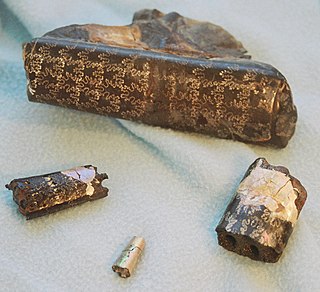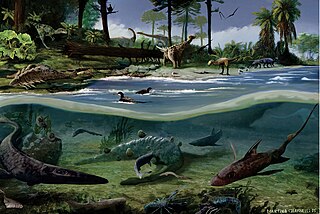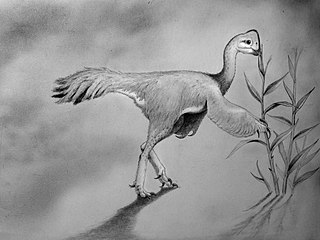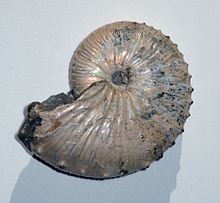Mesodma is an extinct genus of mammal, a member of the extinct order Multituberculata within the suborder Cimolodonta, family Neoplagiaulacidae. It lived during the upper Cretaceous and Paleocene Periods of what is now North America. The earliest definitive record is from the late Santonian stage strata of the Straight Cliffs Formation. A single premolar tooth from the lower Cenomanian stage strata of the Cedar Mountain Formation has been tentatively assigned to this genus based on its similarity, but its describers noted that it is unlikely that Mesodma lived during that time.

Baculites is an extinct genus of heteromorph ammonite cephalopods with almost straight shells. The genus, which lived worldwide throughout most of the Late Cretaceous, and which briefly survived the K-Pg mass extinction event, was named by Lamarck in 1799.

The Maastrichtian is, in the International Commission on Stratigraphy (ICS) geologic timescale, the latest age of the Late Cretaceous Epoch or Upper Cretaceous Series, the Cretaceous Period or System, and of the Mesozoic Era or Erathem. It spanned the interval from 72.1 to 66 million years ago. The Maastrichtian was preceded by the Campanian and succeeded by the Danian.
The Campanian is the fifth of six ages of the Late Cretaceous Epoch on the geologic timescale of the International Commission on Stratigraphy (ICS). In chronostratigraphy, it is the fifth of six stages in the Upper Cretaceous Series. Campanian spans the time from 83.6 to 72.1 million years ago. It is preceded by the Santonian and it is followed by the Maastrichtian.

Globidens is an extinct genus of mosasaurid oceanic lizard classified as part of the Globidensini tribe in the Mosasaurinae subfamily. Globidens belongs to the family Mosasauridae, which consists of several genera of predatory marine lizards of various sizes that were prevalent during the Late Cretaceous. Specimens of Globidens have been discovered in Angola, Brazil, Morocco, Syria and the United States. Among mosasaurs, Globidens is probably most well known for the highly rounded, globe-like teeth that give it its name.

The Pierre Shale is a geologic formation or series in the Upper Cretaceous which occurs east of the Rocky Mountains in the Great Plains, from Pembina Valley in Canada to New Mexico.

Pachydiscus is an extinct genus of ammonite from the Late Cretaceous and Early Paleocene with a worldwide distribution, and type for the desmoceratacean family Pachydiscidae. The genus' type species is P. neubergicus. Altogether some 28 species have been described.

Hoploscaphites is an extinct ammonite genus from the Upper Cretaceous and the Lower Paleocene, included in the family Scaphitidae.

Sphenodiscus is an extinct genus of acanthoceratacean ammonite. The genus has been found from many continents and is thought to have had a large global distribution during the Maastrichtian stage of the Late Cretaceous. It was one of the last ammonoids to have evolved before the entire subclass became extinct during the Paleocene, which was directly after the Cretaceous–Paleogene extinction event.

Acanthoceratoidea, formerly Acanthocerataceae, is a superfamily of Upper Cretaceous ammonoid cephalopods belonging to the order Ammonitida, and comprising some 10 or so families.

The Snow Hill Island Formation is an Early Maastrichtian geologic formation found on James Ross Island, James Ross Island group, Antarctica. Remains of a paravian theropod Imperobator antarcticus have been recovered from it, as well as the elasmarian ornithopods Trinisaura santamartaensis, "Biscoveosaurus" and Morrosaurus antarcticus, the ankylosaurian Antarctopelta oliveroi, and the shark Notidanodon sp. Alongside these described genera are also the remains of indeterminate elasmosaurids, lithostrotian titanosaurs and an indeterminate pterosaur.

The Saratoga Chalk is a geologic formation in Arkansas. It preserves fossils dating back to the Cretaceous period, specifically ammonites.

Kaikaifilu is an extinct genus of large mosasaurs that lived during the Maastrichtian stage of the Late Cretaceous, in what is now northern Antarctica. The only species known, K. hervei, was described in 2017 from an incomplete specimen discovered in the López de Bertodano Formation, in Seymour Island, Antarctic Peninsula. The taxon is named in reference to Coi Coi-Vilu, a reptilian ocean deity of the Mapuche cosmology. Early observations of the holotype classify it as a member of the subfamily Tylosaurinae. However, later observations note that several characteristics show that this attribution is problematic.

The Globidensini or Globidentatini are a tribe of mosasaurine mosasaurs, a diverse group of Late Cretaceous marine squamates. Members of the tribe, known as "globidensins" or "globidensine mosasaurs", have been recovered from North America, Europe, Africa and Asia. The tribe contains the genera Globidens, Carinodens, Igdamanosaurus, Harranasaurus and Xenodens. Features of the maxilla and digits make the placement of Carinodens and Xenodens in the tribe uncertain; some researchers have suggested that they may be more appropriately placed in the Mosasaurini.

Leptorhynchos is an extinct genus of caenagnathid theropod from the Late Cretaceous of what is now the US state of Texas, although it has been suggested to also exist in Alberta and South Dakota. The type species is L. gaddisi, and it is currently the only widely accepted valid species. The generic name of Leptorhynchos comes from the Greek "leptos" meaning "small" and "rhynchos" meaning "beak". The specific epithet is in honor of the Gaddis family, who owned the land on which the holotype was discovered.

Imperobator is a genus of probable unenlagiid paravian theropod dinosaurs, that lived during the Maastrichtian age of the Late Cretaceous in what is now James Ross Island in Antarctica. Imperobator is one of only two non-avian theropods known from Antarctica, crossing over to the landmass when it was part of Gondwana. The only described specimen was found in 2003 by an expedition launched by the University of California Museum of Paleontology and initially described as a dromaeosaur in 2007. The fossil was formally described as a new genus in 2019, and later searches reported more fossils from the site including teeth and skull bones.

Gypsonictops is an extinct genus of leptictidan mammals of the family Gypsonictopidae, which was described in 1927 by George Gaylord Simpson. Species in this genus were small mammals and the first representatives of the order Leptictida, that appeared during the Upper Cretaceous.

Eubaculites is an extinct genus of cephalopods in the family Baculitidae and each known species was initially placed within the related genus Baculites until it was placed in a separate genus in 1926.

Diplomoceras is a genus of ammonites included in the family Diplomoceratidae. Fossils of species within this genus have been found in the Late Cretaceous sediments. D. maximum had coiled shell length about 1.5 m (4.9 ft), uncoiled shell being 3 m (9.8 ft) to over 4 m (13 ft), with body chamber around 2 m (6.6 ft). Some partial specimens may belong to shell with length around 1.7 m (5.6 ft). Studies of Diplomoceras suggest that members of this genus could reach lifespans of over 200 years.

Yatenavis is an extinct genus of enantiornithine bird from the Late Cretaceous Chorrillo Formation of Santa Cruz Province, Argentina. The genus contains a single species, Y. ieujensis, known from a partial humerus.


















